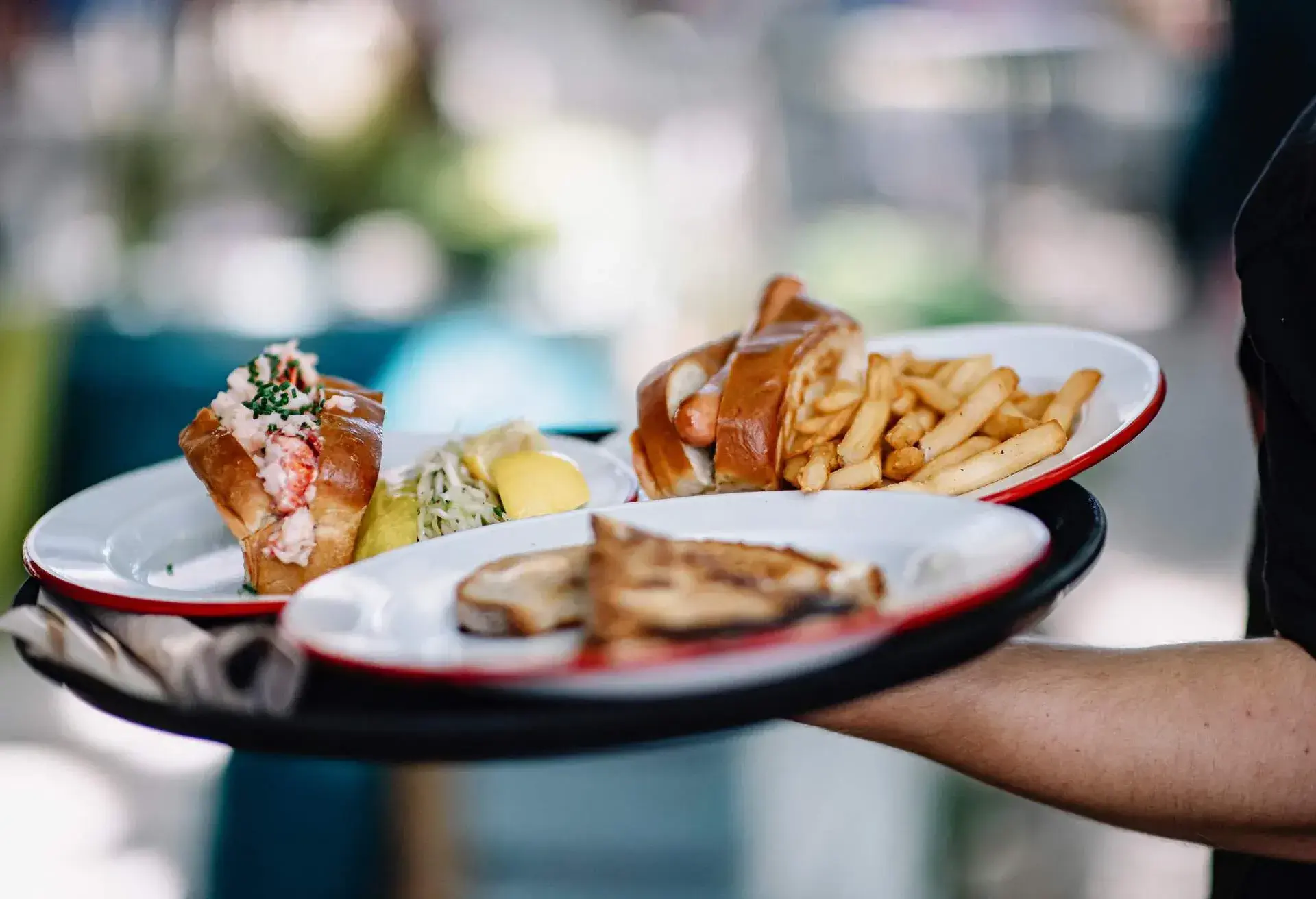Sampling traditional Canadian foods isn’t just a treat for your taste buds. It’s also a great way to uncover interesting success stories that have left their mark on Canada’s foodscape. In keeping with modern times, you’ll find many recipes have been modernised with surprising results. So, loosen up your belts and get ready for a tantalising journey through some of Canada’s most exciting and enticing offerings.
Must-try traditional Canadian food

Just like its scenery, Canadian food has a wide range of origins. From the indigenous peoples that first occupied these lands to the immigrants that brought their cultures with them, each of its dishes are entwined with the long-standing history.
Lobster fisheries in Canada started trading as far back as the 1890s when the crustacean was still relatively unknown and inexpensive. Similarly, soups such as the split pea soup were brought over to Canada by French migrants during 17th century. And then there’s the bannock: a favourite flatbread that can trace its roots to Scotland. This is the diverse landscape of Canada’s cuisine that is sometimes unexpected but very often tasty.
1. Poutine
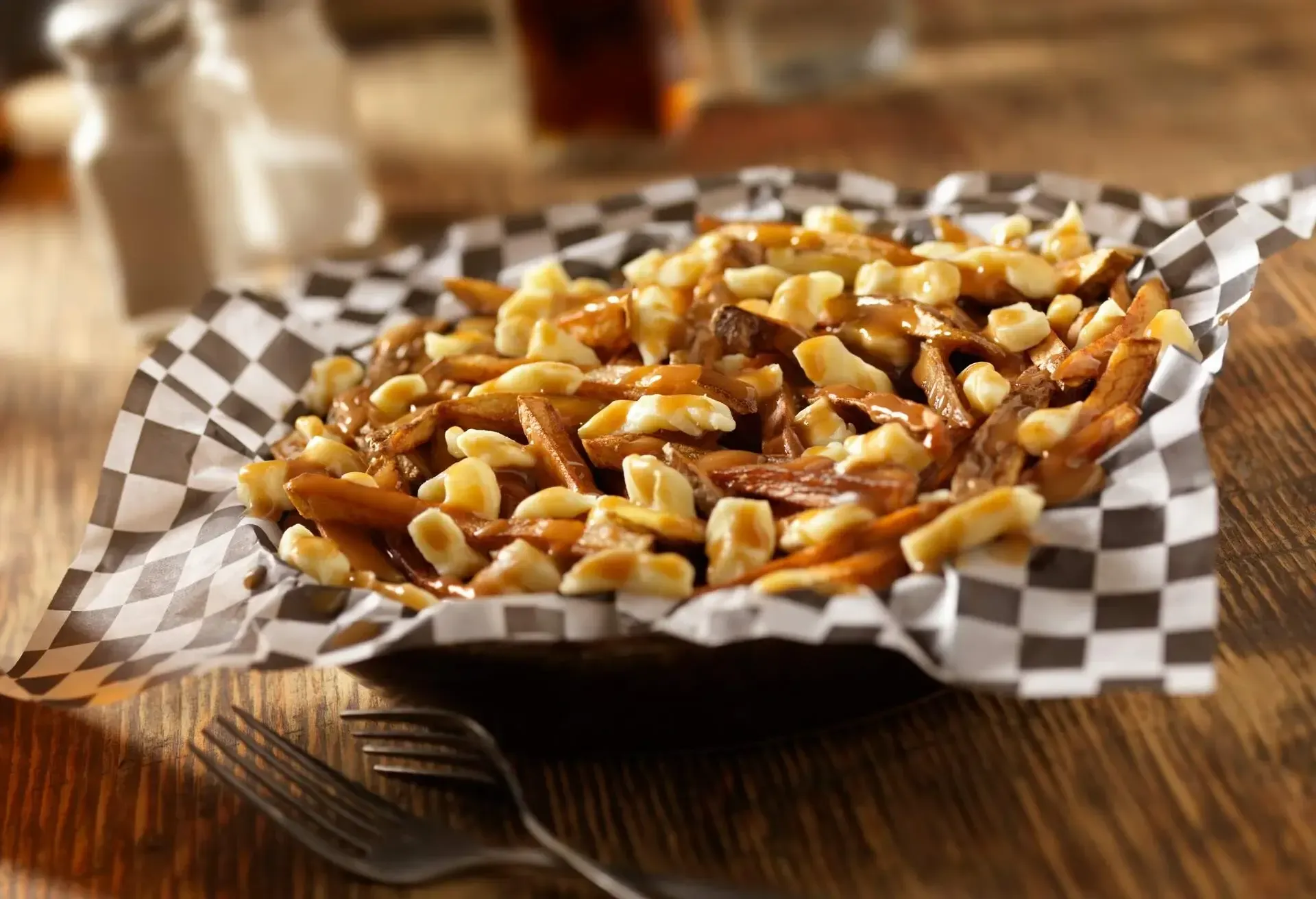
It goes without saying that poutine is the most famous Canadian fast foods. It’s a fine example where simple ingredients are combined to create magic on a plate. This humble plate of crispy French fries is topped with cheese curds before it’s smothered in gravy. It’s the height of comfort food and can be found almost everywhere in Canada and the world over.
A dish that creates controversy, with many laying claim to its creation, there’s no doubt that poutine was first eaten in the late 1950s in rural Quebec. It’s thought to have spread to other parts of the country in the 1960s. By the 1970s, versions of it had even reached New York. Not bad for a plate of fries and cheese with gravy poured over it to keep it warm!
It may have started life as a street food or snack, but you’ll now find variations of this Canadian food in high-end restaurants including bacon, chicken or even lobster. To sample authentic versions of it, Quebec – one of the best cities in Canada – is where to go. You’ll find all sorts of restaurants and fast-food chains dishing it up. Frite Alors is a good one, with venues in the trendy Montcalm or Limoilou districts.
2. Bannocks
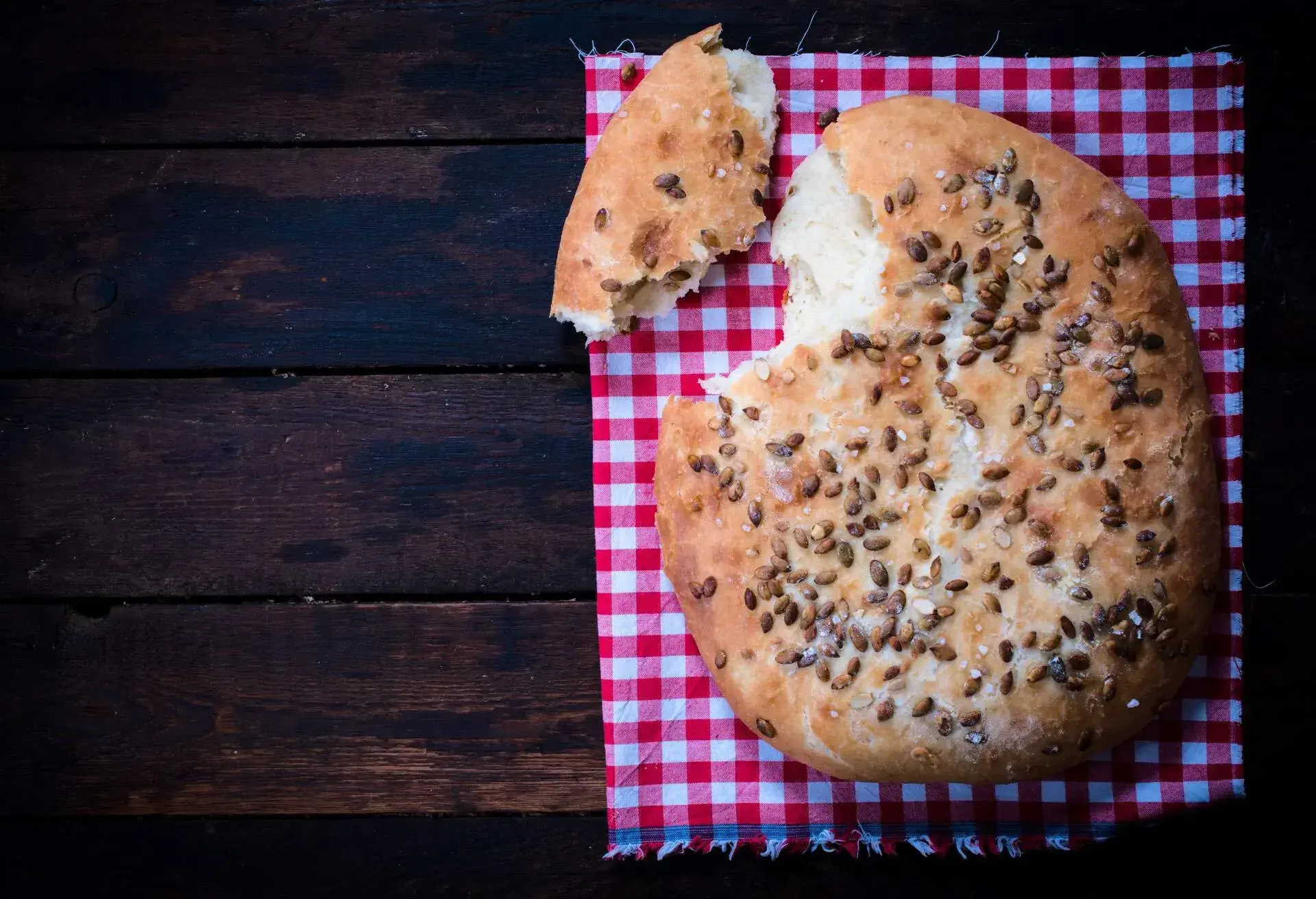
We can’t talk about Canadian traditional food without mentioning the bannock. A flatbread made with flour, water and fat, you will now find variations that use milk, salt and sugar. This delicious bread comes either baked, producing a dense bread, or a lighter, fluffier version that is fried. It also comes with a range of toppings, including bacon amongst others.
Thought to have been introduced into Canada by Scottish migrants in the 18th and 19th centuries, the old bannock was baked using oatmeal. Locals adapted it using wheat flour, corn flour and local plants to suit their own tastes. It’s now become a popular Canadian food, with bakeries around the country dishing it up in various forms.
In Vancouver, Salmon ‘n’ Bannock Restaurant serves this delicious bread with outlandish toppings. What sounds better than a bannock topped with sauteed mushrooms, melted cheese and sage blueberries doused with bison gravy? They even have gluten-free versions, which you can enjoy simply with jam.
3. Nova Scotia Lobster Roll

With an impressive coastline, the cuisine of Canada is permeated with some of the best seafood in the world. Ranging from smoked Atlantic salmon to the more decadent East Coast lobster, you’ll be spoilt for choice. It’s therefore not surprising that one of the favourite Canadian rolls involves seafood: the Nova Scotia lobster roll. Even though the first listings of this delicious roll appear on a menu in a restaurant in Connecticut in the 1920s, lobster in a bun is thought to have been served by fishers in New England as early as the 1890s.
However, it didn’t become popular until 1993, when the McLobster was born. Now, you can’t go anywhere in Nova Scotia without finding this popular Canadian food. If you can’t get enough of it or don’t know where to start, check out the Nova Scotia Lobster Trail. It details all the impressive spots, around 45 of them, where you can indulge.
4. Montreal Bagel

New York may claim to have some of the best bagels, but in Canada, the Montreal bagel reigns supreme. If the question “what do Canadians eat?” has ever crossed your mind, then this is it; well, amongst other things too, but this is iconic. It’s denser, thinner and sweeter than the NY version, as here it’s dunked in honey before baking in a wood-fired oven. Ever present on almost any breakfast menu, how better to enjoy it than served warm from its very source?
The best place to have your Montreal bagel is of course in Montreal and more precisely at Fairmont Bagel. This bakery has been running since 1949 and is most probably the oldest in town. Apart from the classic bagel, which comes sprinkled with sesame seeds, modern variations include chocolate chip and blueberry bagels. That’s your sweet tooth taken care of! You could also pick up a cheesy one from the Nosherz deli and head for a picnic at the nearby Yitzhak Rabin Park.
5. Peameal Bacon
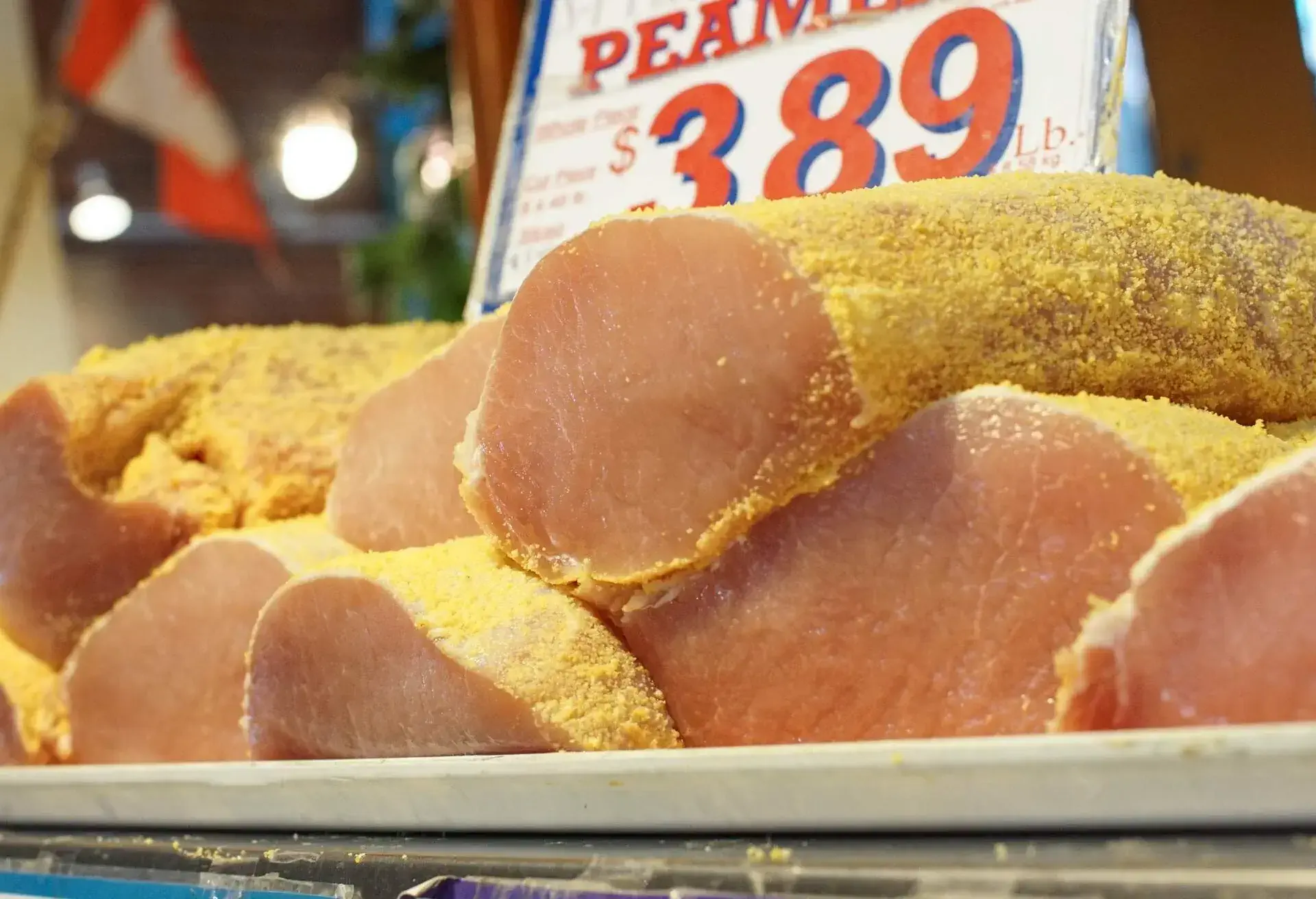
One of the best Canadian delicacies, peameal bacon, was invented by one William Davies from England in 1854. Wanting to find ways to preserve his pork loins for export, he found that they travelled better and kept for longer if he rubbed them with crushed yellow peas.
These days, this classic Canadian food is made with lean pork rolled in corn meal which gives it its distinct colour. Not only is it leaner than normal bacon, but it’s also much more succulent. Toronto serves up some of the best Canadian dishes featuring this speciality. Carousel Bakery is thought to have created the first peameal bacon sandwich in the 1960s, using trimmings from a nearby butcher. It’s served in a bun with honey mustard and is perfect for a quick lunch in between sightseeing.
6. Montreal Smoked Beef
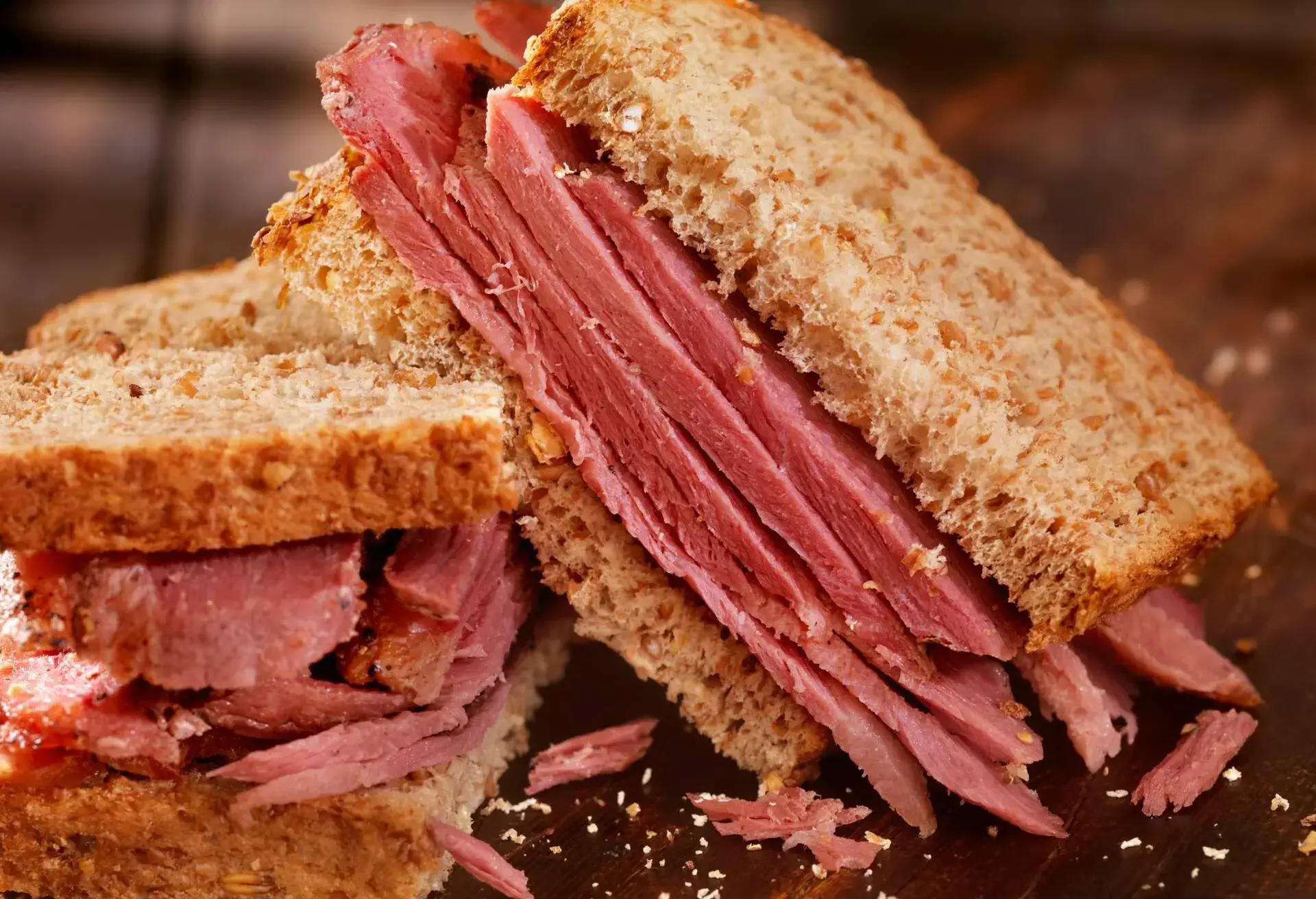
Hot on the heels of the peameal bacon is the smoked beef sandwich. This isn’t just any old sandwich. The Montreal smoked beef sandwich is made with cured beef, not unlike the pastrami, that’s been cured in a range of spices for about a week. The meat is then smoked before steaming to produce a perfectly tenderised scrumptious piece of beef.
Typically, the meat is layered between two slices of rye bread and spread with a piquant yellow mustard to create a lip-smacking sandwich. Sometime a pickled gherkin is added to complete the flavour explosion. This is easily one of the most famous Canadian foods. To try it, head to Schwartz Deli in Montreal. It’s been running since 1928 and is now a cultural – and culinary – institution.
7. Halifax Donair
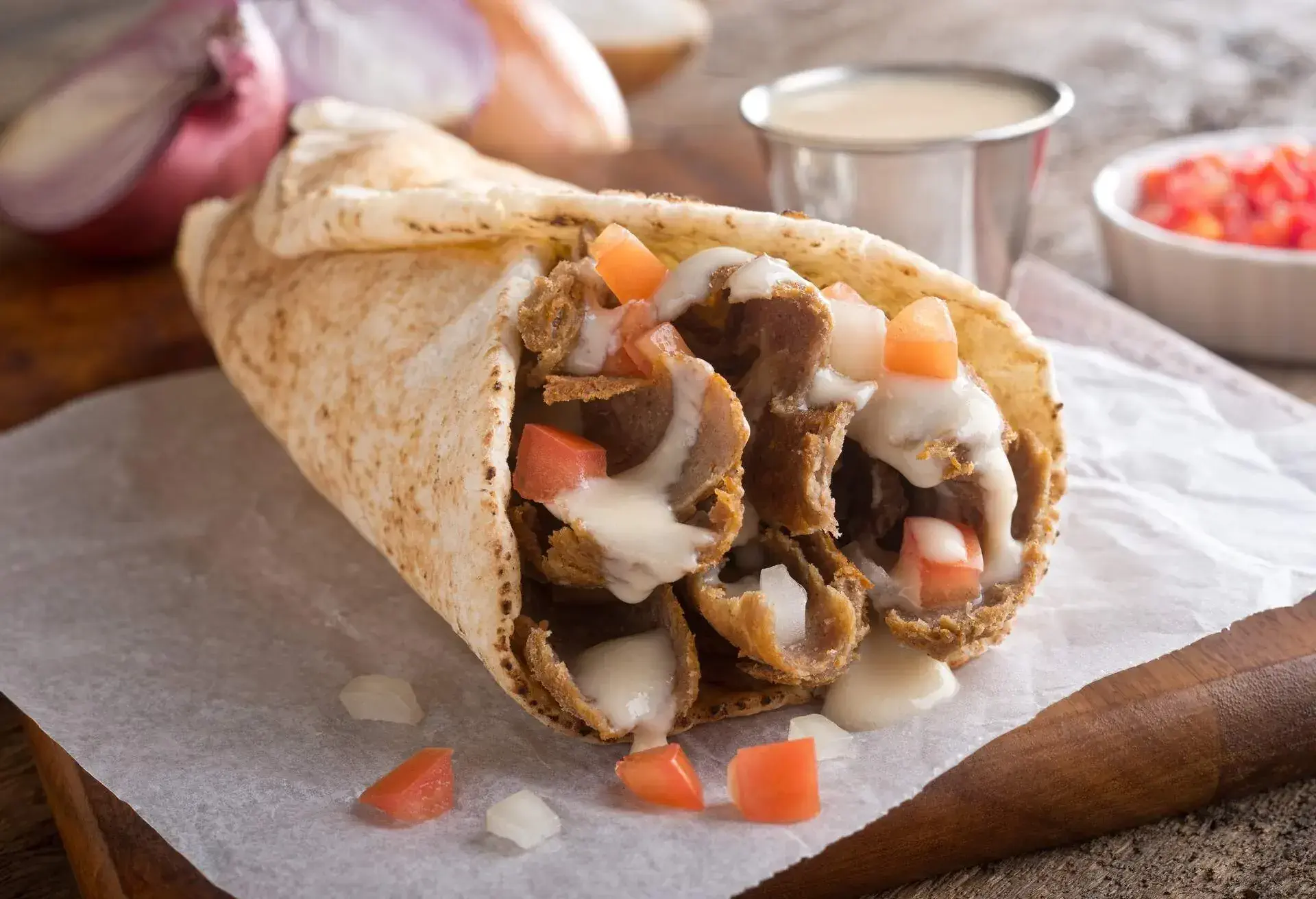
If you head to Halifax, as of 2015, the city’s official food is the donair. This popular snack is favoured by night owls and is perfect to soak up any alcoholic indulgences. Made with shaved pieces of beef roasted from a rotating vertical skewer, they are then stuffed onto warm pitta bread. To complete the ensemble, tomatoes and onions are added with a dousing of a sweet garlicky sauce.
The Halifax donair is very much a celebration of an immigrant craving food from his home country. In this case, Greece. And there’s no better place to sample it than King of Donair – where it was first invented and served in 1973.
8. French Canadian Tourtiere
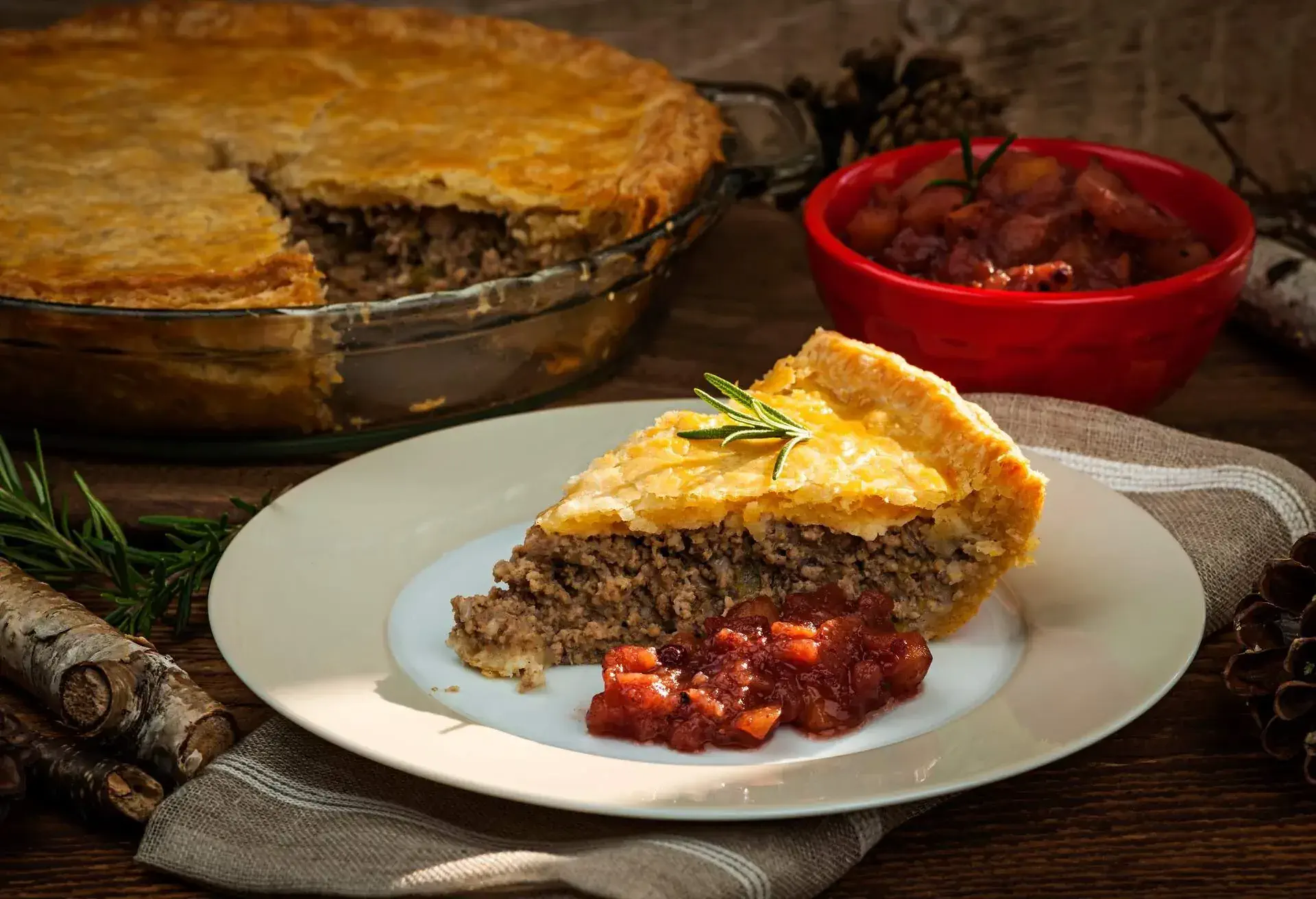
For classic French-Canadian food, there’s none better than the tourtiere: Quebec’s signature dish. Made with minced meat, this double-crusted pie is filled with potatoes and onions and spiced with cloves, nutmeg and cinnamon. You’ll find it served with a chilli dip accompanied by homemade tomato sauce.
Although traditionally eaten during the holidays, this moreish pie can be enjoyed any time of the year. Aux Anciens Canadiens (a restaurant based in the oldest house in Quebec) serves up an authentic tourtiere. You won’t find a better environment to enjoy it than among the collector’s items and antiques found in the house which was once owned by the author, Philippe Aubert de Gaspe.
9. Split Pea Soup
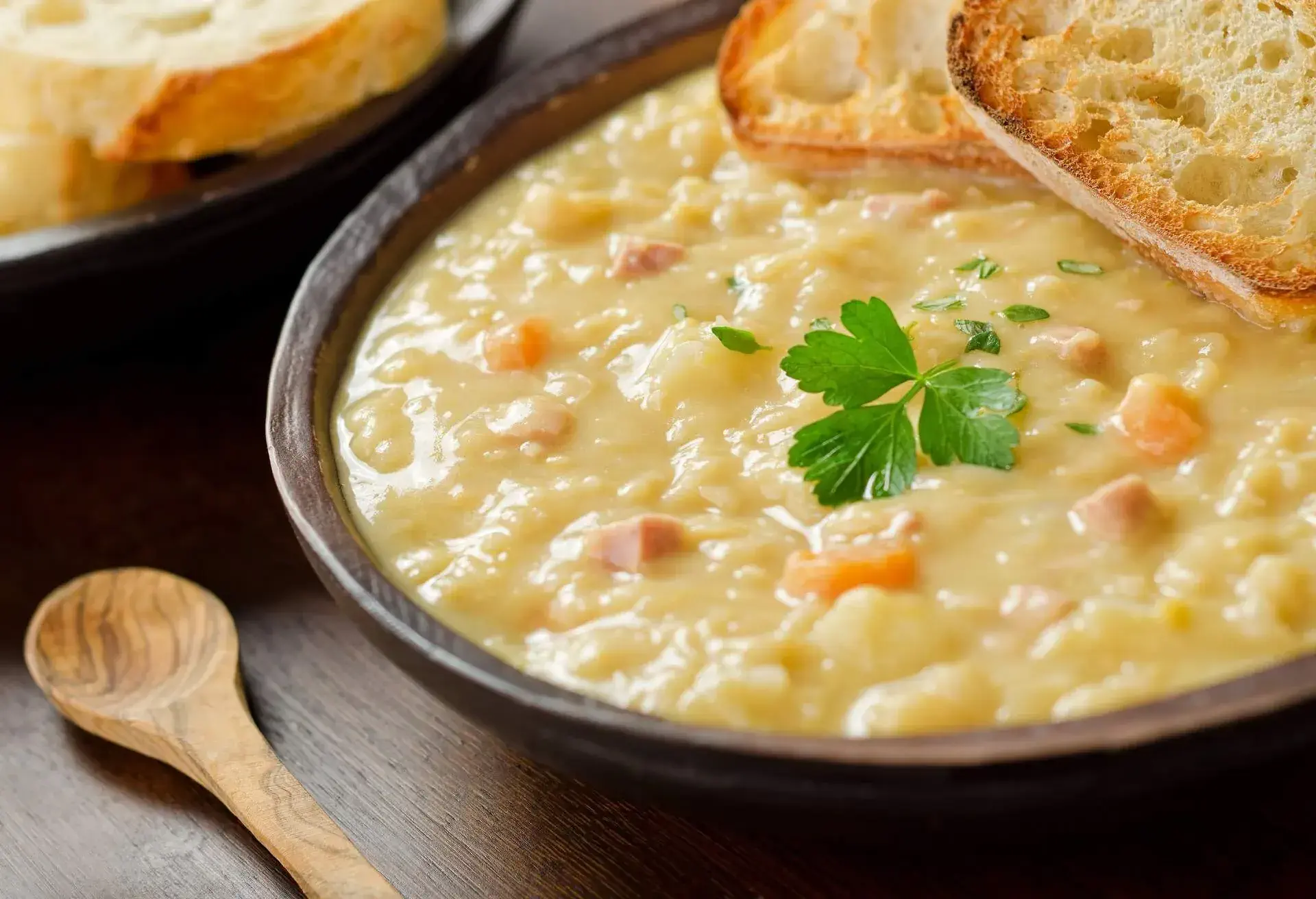
With the type of temperatures Canada experiences, especially in the winter, it comes as no surprise that some traditional Canadian meals should include soups. Nothing is more comforting and warming than a bowl of soup. The split pea soup, with Quebecois origins, is earthy, creamy and utterly delicious.
Originally made with split peas and ham hock, it’s thought to have come to Quebec with French immigrants as early as the 17th century before spreading to other parts of Canada. In Newfoundland and Labrador – both popular camping destinations – it’s made using pork or ham. Locals especially enjoy it at Easter when it’s made using leftover ham. You’ll find its often paired with doughboys: large dumplings that can be used to scoop up the tasty soup.
Canadian food: sweets and snacks
If you have a real sweet tooth or you’re simply after a local snack, Canada won’t disappoint. From moreish pies to crinkle-cut crisps (or chips if you’re a local), there’s no shortage of treats to try.
10. Maple Taffy
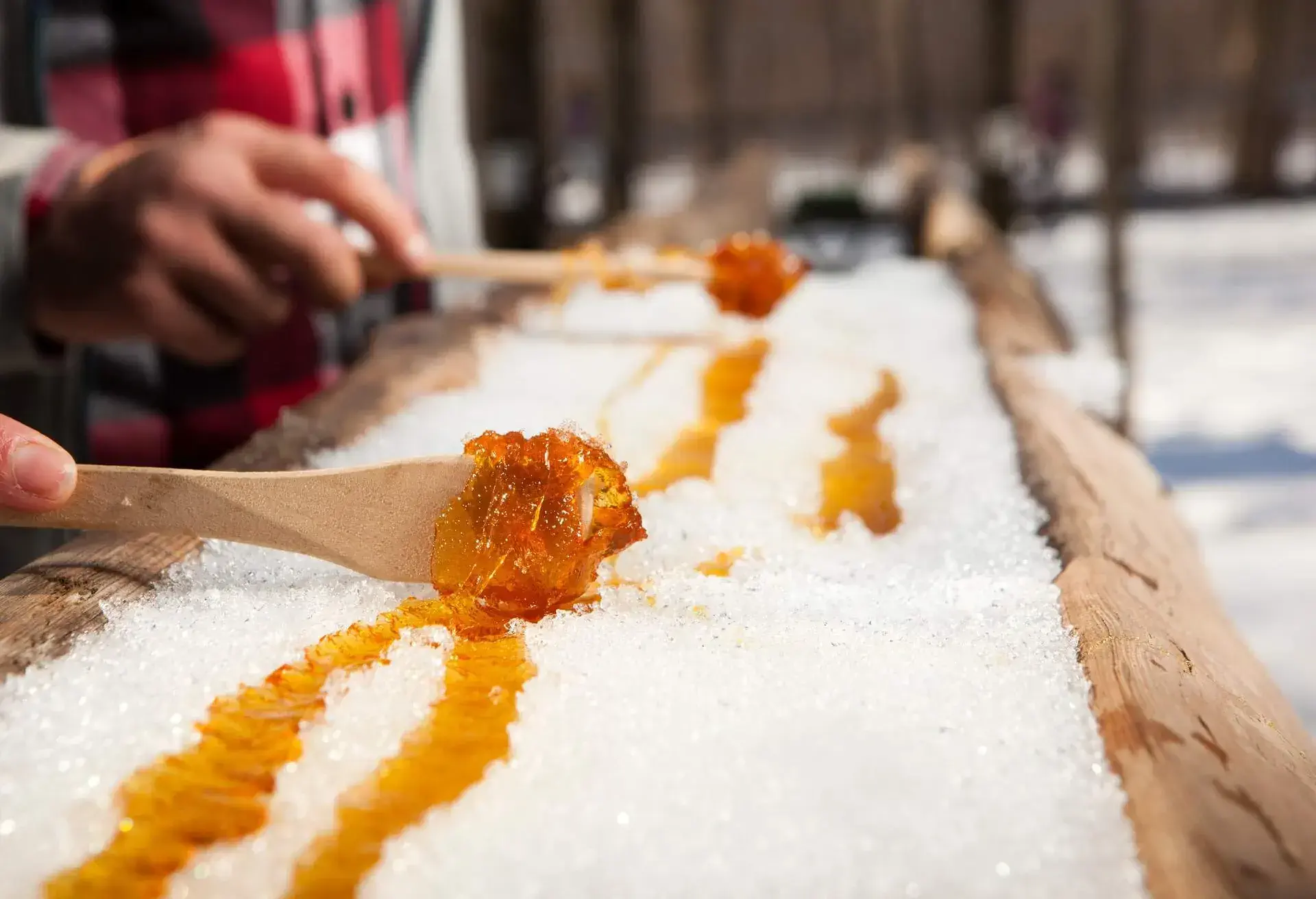
At the very top of Canada’s sweet treats is the maple taffy. It’s made with one of Canada’s biggest exports: maple syrup. A toffee of sorts, the hot maple syrup is poured over snow which causes it to harden immediately. Then, using a popsicle stick, you roll it up and enjoy as you please. It’s without a doubt the most common of Canada’s famous foods, especially during the winter months.
11. Ketchup Chips

For those who prefer a savoury snack, look no further than ketchup chips: a typical Canadian food snack. Though the origins aren’t known, it’s been a favourite of Canadians from as early as the 1970s. You’ll find it comes in many shapes and forms – from thick and crispy to baked or even crinkly. The flavours, as many Canadian foods are, may sometimes be shocking. They range from your typical salt or vinegar to BBQ and even poutine – who can resist?
12. Saskatoon Berry Pie
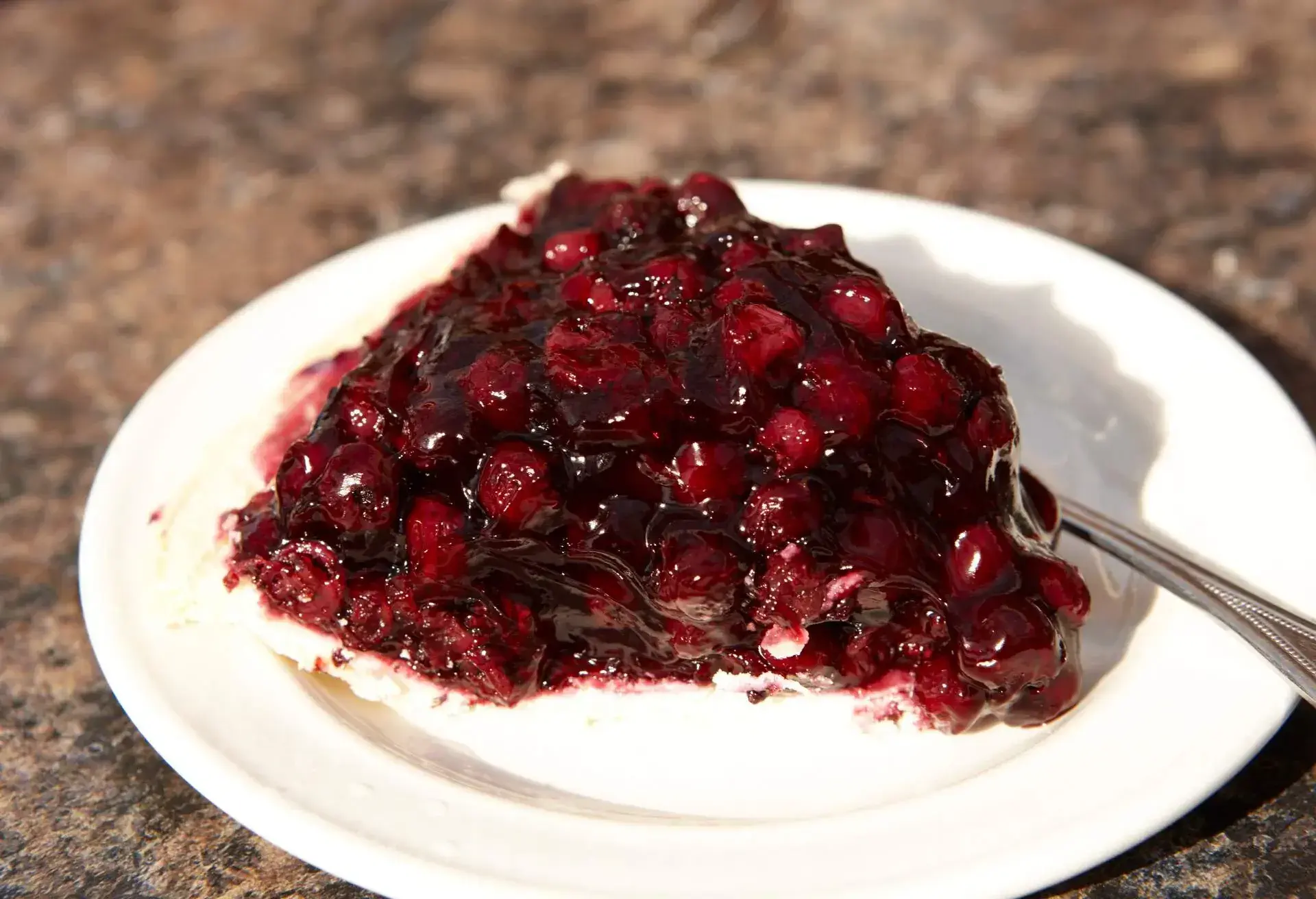
Out in the Canadian prairies, there is an abundance of berries. One in particular gave a town its name and is also a main ingredient of a beloved Canadian desert: the Saskatoon berry pie. A bluish-purple berry, it’s got a distinct flavour and was a favourite of the indigenous people who harvested and preserved it to be used in the winter months.
Saskatoon berry pie features a pie pastry filled with delectable berries, sugar and butter before being baked in the oven. Once baked, the pie oozes with flavour and is even more delicious topped with vanilla ice cream. It’s best enjoyed in the summer months between June and August, when the berries are in season.
The Berry Barn, on the picturesque South Saskatchewan River in Saskatoon, is where to indulge your sweet tooth. Though open seasonally, it’s well worth a visit – especially if you’re travelling with hungry kids.
13. Nanaimo Bars
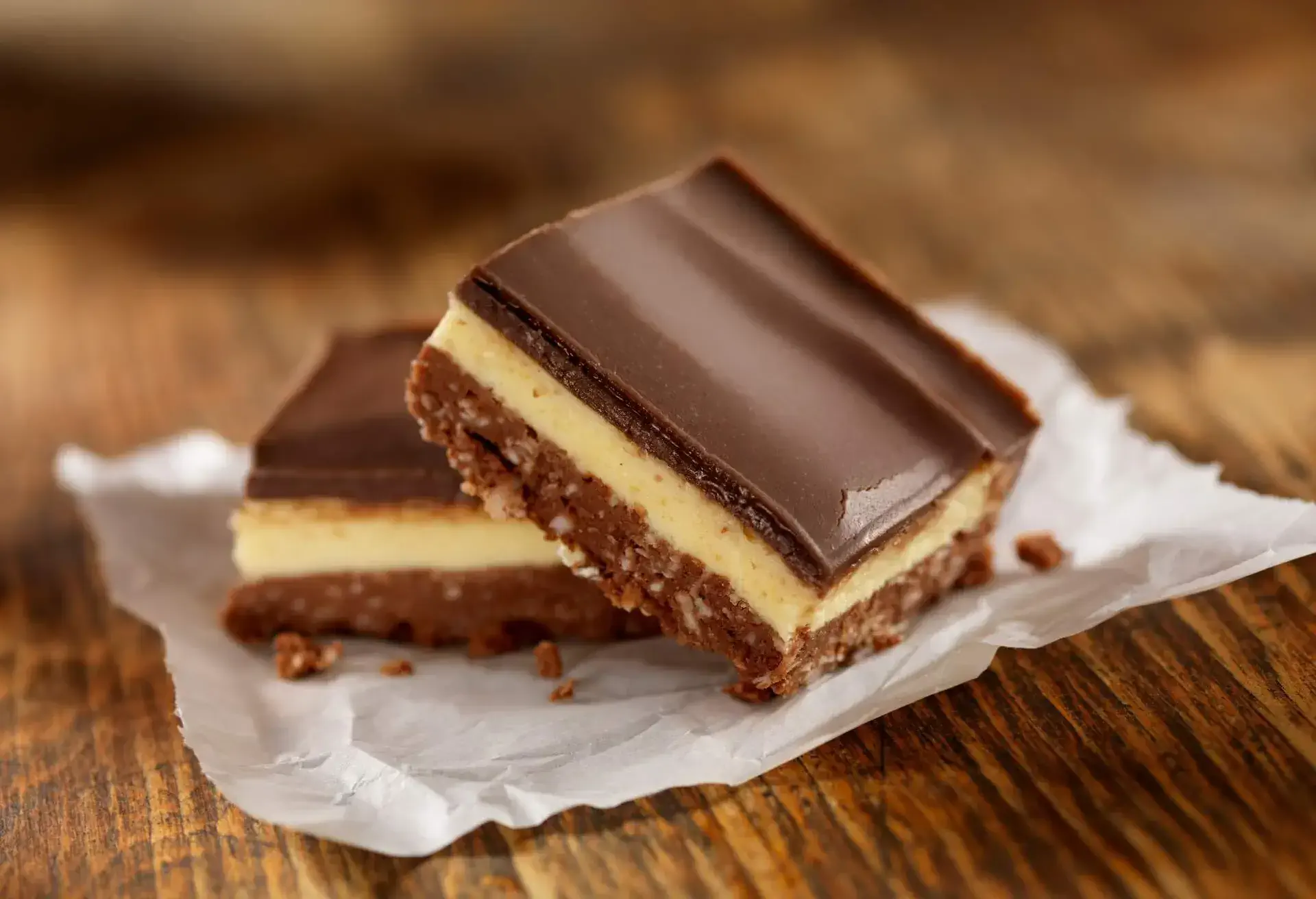
Another town that this time gives its name to a popular Canadian dessert is Nanaimo in British Columbia. The dessert in question is none other than the Nanaimo bar – a delightful three-layered treat that requires no baking and will satisfy any chocolate cravings.
The bottom layer is made from a crispy coconut biscuit base topped with a thick custard before being crowned with a chocolate ganache. What you’re left with are contrasting layers of crunchiness, soft gooeyness and chocolate heaven. Its origins are far ranging but it’s thought to go as far back as WWII. They’re thought to have been made popular in the 1970s by a local named Susan Mendelson who commercialised them to pay her way through college.
14. Butter Tarts

When it comes to desserts, often simplicity is key. Take the butter tart, for example. Soft and flaky on the outside while oozing delicious gooeyness on the inside. It’s made simply by filling a pastry case with a mix of sugar, butter, syrup and eggs.
Some regional varieties also add raisins – but this often sparks debate. Why not make up your own mind by trying both? The best opportunity to do so is in Ontario along the Wellington County Butter Tart Trail which features roughly 17 wonderful spots to sample it. You’ll find a range of fillings, too, from pecans and blueberries to white chocolate. Delicious!
Refreshing Canadian drinks
What better way to wash down all the best Canadian dishes than a refreshing local beverage? Here’s one to try during your travels around the country.
15. Caesar Cocktail
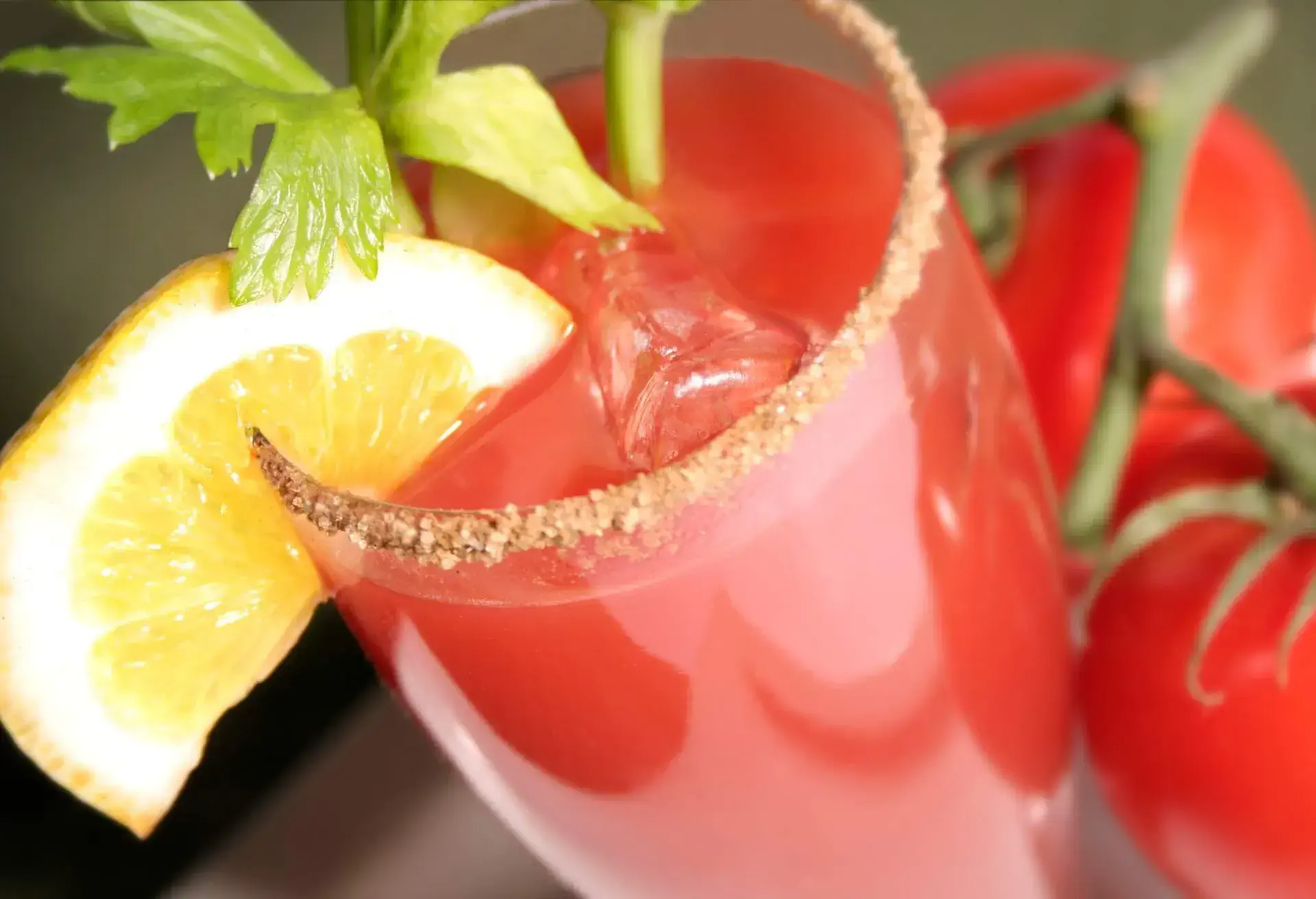
It’s perhaps only right to mention a drink that’s favoured by most Canadians, especially for brunch: the Caesar. It’s Canada’s national cocktail and, just like the Bloody Mary, it’s made with vodka, tomato juice, Tabasco and Worcestershire sauce. That’s where the similarities end, however. In Canada, the garnishes are what it’s become famous for.
These range from simple onion rings, sliders and hot dogs to even a whole roast chicken! In Vancouver, the recommended place to enjoy one with brunch is Score on Davie: a gastropub that has become a firm favourite with both locals and travellers alike. Try the corn dog with dill and honey mustard accompanied by onion rings.
More food inspiration
If you’re a foodie, it’s not just Canada where you can devour some delicious cuisine. Uncover more Italian street food and Italian food traditions. Or why not inspire your next trip with KAYAK’s guide to traditional food in Germany? Spain is also well known for its food culture, while you’ll find a melting pot of foods in Dubai.

